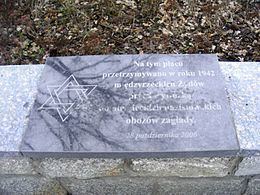Victims 20,000 Jews | ||
 | ||
Incident type Imprisonment, mass shooting, forced labor, starvation, deportations to death camps Perpetrators Nazi SS, Orpo police battalions | ||
The Międzyrzec Podlaski Ghetto was one of the World War II ghettos established by Nazi Germany for the local Jewish population of Międzyrzec Podlaski in the semi-colonial General Government territory of occupied Poland. The ghetto was liquidated in stages between 1942 and 1943 as part of the Final Solution, with all Jews either killed on the spot in mass shooting actions or deported to Treblinka and Majdanek death camps.
Contents
Ghetto history
At the end of September 1939, during the Soviet invasion of Poland, the Red Army conquered the city of Międzyrzec Podlaski. At the beginning of October, the Soviet Union handed over the city to Germany as part of the brand new Nazi-Soviet Border Treaty amended to the secret Hitler-Stalin Pact against Poland in 1939. Following the exchange, approximately 2,000 of the city’s Jews left for the Soviet-occupied zone. The Germans set up a transfer ghetto in the historic neighbourhood of Szmulowizna. It held 20,000 Jewish prisoners at its peak. On August 25–26, 1942 some 11,000–12,000 Jews were rounded up by German Ordnungspolizei amid gunfire and screams and loaded onto Holocaust trains to Treblinka extermination camp.
The next mass extermination action took place around October and November 1942. "Strip-search" of young Jewish women was introduced by Oberleutnant Hartwig Gnade before executions dubbed "mopping up" actions. His first sergeant later said: "I must say that First Lieutenant Gnade gave me the impression that the entire business afforded him a great deal of pleasure." The wave of mass killings lasting non-stop for several days were conducted by the Trawniki battalion of about 350 to 400 men, while the Germans from the parallel Reserve Police Battalion 101 of the Ordnungspolizei from Hamburg dealt with unruly crowds of thousands of ghetto inhabitants.
On the seventeenth of July 1943, the ghetto was liquidated, with all remaining Jews deported to Treblinka and Majdanek death camps; at which time the last 160–200 residents were shot, and the city was officially declared free of Jews. Fewer than 1% of the Jewish population of the city survived the German occupation.
Rescue attempts
During the ghetto liquidation in Międzyrzec, Mojżesz Bekerman (whose wife Cypa was already murdered), managed to escape with his two sons: Szmul-Leib, and Fajwel. They reached the farm of Polish Christians Władysław and Marianna Michalak who put them in a barn filled with hay, and turned it into their home for the next two years. All survived. The Michalaks were thanked for their completely disinterested help by Fajwel Bekerman in his postwar testimonies. Another Jewish townsman, Sender Dyszel, also managed to escape shootings in Międzyrzec. He was rescued by Polish Righteous Franciszka Abramowicz (1899–1990). She brought him food into the forest until he could return to her later. Dyszel emigrated to Argentina after 1947.
Jews of Międzyrzecz were provided with fake baptismal certificates by Rev. Albin Horba until the final liquidation of the ghetto. He was transferred to local parish in May 1942 after sheltering several prominent Jews in Świsłocz. When the Red Army rolled into the city, Horba was arrested by the Soviet secret police, and held in prison until April 1948.
